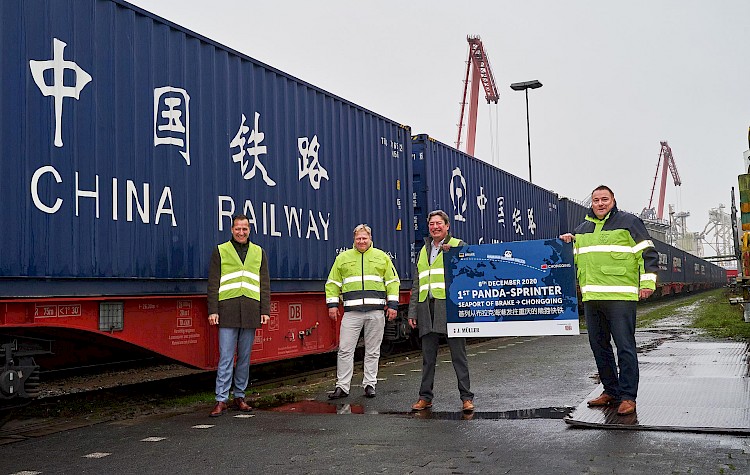08.12.20
PANDA SPRINTER – NEW LOGISTICS CONCEPT AT THE BRAKE SEAPORT: FIRST DIRECT TRAIN WITH PULP TO CENTRAL CHINA

J. MÜLLER organises the first direct train with pulp to Chongqing, China
Today, the first direct train with 1,000 tonnes of pulp will take off from Brake seaport to Chongqing, China. It provides an additional, faster and above all environmentally-friendly way of connecting Northern Europe with Central China.
In recent years, the Brake seaport has developed into the German forestry products hub, handling 1.2 million tonnes of pulp alone each year – with an upwards trend.
This year, J. MÜLLER invested 13.8 million euros in the construction of new warehouses for packaged goods with a total area of almost 28,000 square metres.
Today, more than 65% of the incoming pulp will already leave the port by rail – so far only to the European hinterland, but now also to China along the Silk Road. Railway volumes are supposed to be further expanded with DB Cargo in order to meet customers’ needs for speed and sustainability even more effectively.
In the future, J. MÜLLER will continue to focus on expanding its pulp handling with intent to target the growth market of Asia and the countries of the former USSR. With the rail connection to Chongqing, an express connection will be established that will not only transport pulp quickly, environmentally friendly and safely, but can also be used to transport other products to China and back.
In recent years Chongqing, an up-and-coming mega-city in southwest China with 34 million inhabitants, has become a magnet for diverse industries and has increasingly established itself as a ‘new technology’ hub. The demand for raw materials and goods is enormous.
The city of Chongqing, however, is located 2,000 km away from China's coast and its ports. The supply of goods and raw materials by barge on the Yangtze River, the most heavily trafficked river in the world, takes at least 14 days with no waiting time. Usually, waiting times at the locks are very long, with costly reloading from barge to truck and back again when the river is not navigable [high and low tide]. Before being transported by barge from Changshu [near Shanghai], China’s largest pulp importing seaport, the goods have already completed a sea voyage lasting several weeks, depending on the country of origin. In comparison: With the direct railway connection from Brake to Chongqing, the goods will reach their destination in only 14 to 16 days – safely and environmentally friendly.
DB Cargo and J. MÜLLER experts have developed their own railway product for this new transport method, the so-called ‘Panda Sprinter’. The infrastructure operator Niedersachsen Ports [NPorts, Lower Saxony, Germany] provided the railway tracks in Brake. On its journey of more than 10,000 kilometres from Brake to Chongqing, the container train has to change track width twice. China uses the same rail track width as Europe. However, Belarus, Russia and Kazakhstan use a wider gauge. Therefore, the containers must be transhipped onto new cargo wagons at the Polish-Belarusian and Kazakh-Chinese borders.
Additional trains are already being planned for the period after the test phase with the first pulp train, which is expected to arrive in Chongqing at Christmas. DB Cargo and J. MÜLLER want to jointly expand this logistics concept further in the future for customers in other industries.
Weitere News & Events
12.04.24
Feierliche Einweihung der größten Dach-Solar-Anlage Niedersachsens
J. MÜLLER weiht 62.000 Quadratmeter große Photovoltaikanlage im Seehafen Brake ein....25.02.24
Damage to the Elsfleth-Orth railroad bridge and its impact on the seaport of Brake
In the night from 24 to 25.02.2024, a barge collided with the Elsfleth-Orth railroad bridge on the River Hunte. The collision damaged the bridge and train services have been suspended indefinitely. As a result, the port of Brake is currently inaccessible by rail....10.01.24
